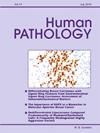Auerbach's plexus invasion as a key pathological factor for predicting outcomes in ampullary carcinoma
IF 2.7
2区 医学
Q2 PATHOLOGY
引用次数: 0
Abstract
Background
Ampullary carcinoma (AC) has a poor prognosis in patients with pancreatic and perineural invasion beyond the duodenal muscularis propria. However, no studies were focused on evaluating Auerbach's plexus (AP) invasion in AC, and its clinical pathological significance remains unclear. In this study, we examined the clinical significance of AP invasion in patients with AC.
Methods
Clinicopathological examinations for AP invasion were performed in 80 patients with AC (median age: 70 years, male-to-female ratio: 43:37) who underwent endoscopic and surgical resection at Kurume University Hospital between 2005 and 2022. Statistical analysis was performed using the Kaplan–Meier method (log-rank test) and Cox proportional hazards models.
Results
The median AC tumor size was 20 mm, and the most common histological type was well-differentiated adenocarcinoma (59/80, 74%). Tumor invasion beyond the duodenal muscularis propria occurred in 38 patients (48%), of whom 21 (55%) had AP invasion. Univariate analysis identified several prognostic factors, including histological type, tumor depth, stage, AP invasion, and lymph node metastasis. Multivariate analysis confirmed AP invasion (hazard ratio = 2.716, 95% confidence: 1.130–6.529, p = 0.026) as an independent prognostic factor. Additionally, patients with AP invasion had a significantly worse prognosis than those without AP invasion (p < 0.001).
Conclusions
AP invasion is a critical prognostic factor in patients with AC. Closer monitoring and more aggressive treatment strategies may be warranted for patients with AP invasion to improve their prognosis.
Auerbach神经丛浸润是预测壶腹癌预后的关键病理因素。
背景:胰腺和十二指肠固有肌周围神经受侵的胰门癌(AC)患者预后较差。然而,目前还没有研究重点评估 AC 中的奥尔巴赫丛(Auerbach's plexus,AP)侵犯,其临床病理意义仍不明确。在本研究中,我们探讨了 AC 患者中 AP 侵犯的临床意义:方法:我们对 2005 年至 2022 年期间在久留米大学医院接受内镜和手术切除的 80 例 AC 患者(中位年龄:70 岁,男女比例:43:37)进行了 AP 侵犯的临床病理检查。统计分析采用 Kaplan-Meier 法(对数秩检验)和 Cox 比例危险模型:中位 AC 肿瘤大小为 20 毫米,最常见的组织学类型是分化良好的腺癌(59/80,74%)。38名患者(48%)的肿瘤侵犯范围超过十二指肠固有肌,其中21名患者(55%)的肿瘤侵犯范围超过十二指肠固有肌。单变量分析确定了几个预后因素,包括组织学类型、肿瘤深度、分期、AP侵犯和淋巴结转移。多变量分析证实 AP 侵犯(危险比=2.716,95% 置信度:1.130-6.529,P=0.026)是一个独立的预后因素。此外,有 AP 侵犯的患者预后明显差于无 AP 侵犯的患者(p 结论:AP 侵犯是 AC 患者预后的关键因素。可能需要对有 AP 侵犯的患者进行更密切的监测并采取更积极的治疗策略,以改善其预后。
本文章由计算机程序翻译,如有差异,请以英文原文为准。
求助全文
约1分钟内获得全文
求助全文
来源期刊

Human pathology
医学-病理学
CiteScore
5.30
自引率
6.10%
发文量
206
审稿时长
21 days
期刊介绍:
Human Pathology is designed to bring information of clinicopathologic significance to human disease to the laboratory and clinical physician. It presents information drawn from morphologic and clinical laboratory studies with direct relevance to the understanding of human diseases. Papers published concern morphologic and clinicopathologic observations, reviews of diseases, analyses of problems in pathology, significant collections of case material and advances in concepts or techniques of value in the analysis and diagnosis of disease. Theoretical and experimental pathology and molecular biology pertinent to human disease are included. This critical journal is well illustrated with exceptional reproductions of photomicrographs and microscopic anatomy.
 求助内容:
求助内容: 应助结果提醒方式:
应助结果提醒方式:


